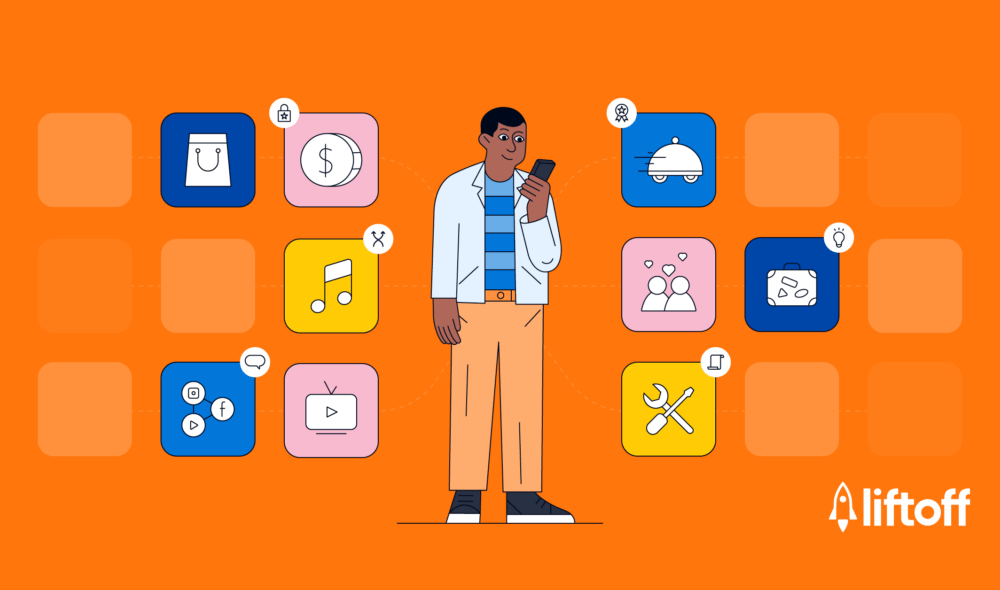AI
Liftoff’s 2025 Mobile Ad Creative Index Reveals UGC Is a Key Differentiator for Top Apps

Major findings from the newly launched report include playable ads having the potential to deliver impression-to-install rates 16 times that of non-playable formats for emerging gaming apps and a 20% increase in spending on interactive ads year over year.
Liftoff, a leading AI-enabled growth platform for the mobile app economy, has published its seventh annual Mobile Ad Creative Index. The report explores top creative trends that are attracting and scaling in ad spend across consumer apps and games. It also highlights the expanding role of AI in creative production, testing, and optimization.
This year’s Mobile Ad Creative Index specifically analyzes creative concepts that have excelled in scale for Liftoff’s highest-spending advertisers over the past 12 to 48 months. It is based on findings from over 4.7 trillion impressions, 263 billion clicks, and 1.1 billion installs between 1 January 2023 and 31 May 2025.
Highlights from the report include:
Top consumer apps are investing in interactive ads to compete for engagement
In 2024, the share of spend on interactive ads for top apps increased by 20% year over year. The share of spend increased by 2% for spenders outside the top tier. Top-spending apps differentiate their campaigns by adding innovations to evergreen concepts such as social scrollers, carousels, and scratch-offs.
Playable ads deliver returns across ad budgets for mobile game advertisers
In 2024, the share of spend on playable ads for top games averaged 35% higher than other games. Across all ad budgets, however, playable ads delivered higher conversion rates. Impression-to-install rates were 8 times that of non-playable formats for top spenders and 16 times that of non-playable formats for other game advertisers.
Tailoring “metaplay” elements to motivations can improve performance
“Metaplay” elements—gameplay that diverges from an app’s core design to appeal to a broader audience—are widespread, but top games gain an edge by tailoring their metaplay ads to the publisher audience. The report found that aligning “metaplay” creative with publisher audiences resulted in a 93% increase in installs-per-mille.
UGC is becoming a key differentiator in driving scale for consumer apps
The share of spend on user-generated content (UGC) increased 11% for top-spending apps, with social and utility apps seeing the most significant jump of nearly 30% between 2023 and 2024.
Widespread adoption of Gen AI leads to more customized ad experiences
Creative teams increasingly leverage AI to enhance top-performing assets with 3D and motion and to create and test variations. Top advertisers also use AI to recombine their assets in customized ad experiences that break away from standard video to playable formats.
Yann Zeller, Chief of Staff, Creative at Liftoff, said: “Today’s creative landscape is shaped by a single, powerful truth: attention is the commodity, and brands, games, and influencers are all vying for it. Great mobile ad experiences can earn attention by aligning context with behavior. As ad formats become richer and AI expands our ability to personalize and adapt creatives at scale, we’re able to unlock new insights into user behavior and motivation. We see users spend meaningful stretches with the right content, sometimes 60 to 90 seconds when the ad feels personal or prompts meaningful participation. This isn’t just a better way to advertise—it’s a better way to tell stories and the most exciting brief we’ve had in years.”
Soren Steelquist, Director of Creative Production, said: “The proof is in the data—more and more consumer apps are incorporating UGC into every stage of their marketing, and programmatic is no different. UGC works because it’s authentic and relatable, and users are more likely to be influenced by ad when it’s coming from a trustworthy source. To see higher impact from UGC creatives, work with a partner that can match the right creator with your brand and develop winning concepts that resonate with audiences.”
The post Liftoff’s 2025 Mobile Ad Creative Index Reveals UGC Is a Key Differentiator for Top Apps appeared first on Gaming and Gambling Industry in the Americas.
AI
RG24seven Virtual Training Collaborates with AI Experts to Expand Responsible Gaming Courses

RG24seven Virtual Training, the industry-leading and free video-based training platform for Tribal and commercial gaming employees, is pleased to offer an exclusive Artificial Intelligence (AI) course presented by Better Change and Mindway AI. The course was first announced during the premiere episode of TALK 24 highlighting the future of AI in Responsible Gaming. The new course will introduce gambling industry employees to the role AI can play in Responsible Gaming initiatives and the gambling industry as a whole.
Wendy Anderson, CEO of RG24seven Virtual Training, said, “Our new AI course aims to enhance RG24seven’s existing Responsible Gaming and Safer Gambling content, introducing new perspectives and insight that align with the latest developments in the field. As part of the fast-growing software company operating science-based solutions, Niamh Gallagher from Mindway AI, presents these courses with a deep understanding of AI.”
Gallagher added, “Promoting responsible gambling is a shared responsibility; our commitment to this training is rooted in collaboration. The gaming industry must be aware of the ethical responsibilities that come with the advancements in AI and ensure that it is used transparently, with clear and ethical guidelines in place to support Responsible Gambling behaviors. Simply taking this course helps gaming employees understand the basics of AI and the critical role it can play when used responsibly.”
Victoria Reed, CEO of Better Change and Strategic Advisor for RG24seven, concluded, “The future of AI in the gaming industry is still being written. It’s not just about the technology itself but it’s about how we choose to use it. AI in the hands of people who are committed to ethics and responsibility, has the potential to be a game-changer for player protection and industry integrity. It’s a future we’re working hard to build and it’s one we believe will benefit everyone involved, which is why we are proud to offer this new course in both the U.S. and the U.K.”
The post RG24seven Virtual Training Collaborates with AI Experts to Expand Responsible Gaming Courses appeared first on Gaming and Gambling Industry in the Americas.
AI
UNLV’s PGA Golf Management University Program partners with Las Vegas-based AI technology company Evenplay to study the effects of rewards on skill level

There’s a timeless adage from NBA great Allen Iverson: “Practice?!” But now, almost ironically, AI (that is, Artificial Intelligence) will be helping us replicate big-time pressure in that very scenario.
Evenplay, an AI technology company based out of Las Vegas, has created a patented golf simulator application that creates challenges for all skill levels, with the intention of improving play performance through the use of cash rewards.
“What we have is a machine-learning algorithm that takes all of your shot data and says, ‘What are you going to do next from 175 yards?,’ and creates targets personalized for your skill level with money on the line,” said Sameer Gupta, co-founder of Evenplay. “If you practice with pressure, you’re probably going to get better faster.”
UNLV has partnered with Evenplay, taking on the task of studying the impact of rewards on skill level, and how well this experience translates the gains from practice into practical use on the real course.
“It sounded like a good opportunity to build a relationship and a bridge with this company,” said Chris Cain, director of the PGA Golf Management University Program within UNLV’s Harrah College of Hospitality. “And to see if we can continue to advance off-course golf, improve diversity in the consumer base, and think a little bit differently and daring, which is what UNLV’s all about.”
Upping the Ante on Research
The ability to create a feedback loop – one where you practice in the same conditions as when something’s on the line – is the goal: replicating the jitters that come from staring down a big putt, and then training yourself to handle the pressure before you step onto the course.
Evenplay does this by paying out money depending on the shot, using rewards as a way to create real stress in a controlled setting.
“What we have is a turn-key stress generator,” said Gupta. “Our model projects a thousand shots from every distance, with a target drawn where about half of your shots should be capable of landing. We’ve taken a skill-based activity and are able to predict what you will do next.”
The study at UNLV uses a more controlled version of the wagers. Randomly selected participants will receive various payouts such as lesson or UNLV Gift certificates based on their group assignments and the level of contributions to the study.
“This is a skill-based gaming application that allows someone to make a bet and have fun doing it,” said Cain. “What we’re doing at UNLV is seeing if the variable payouts influence program retention – do they play longer or more often? Does this also influence skill improvement? Wouldn’t it be cool to have some sort of technology in place that actually uses gaming as a way to positively influence skill improvement?”
The study is made possible through UNLV’s Sports Innovation Institute (SII), and the College of Hospitality’s Center for Golf Management, in collaboration with the university’s International Gaming Institute. The SII acts as a hub for all of the faculty who do research in sports, enabling them to work together to find solutions to problems and advance the commercialization of products fitting that criteria.
“With Evenplay’s expertise, as well as the Sports Innovation and the International Gaming institutes, that trifecta makes for a pretty special partnership here in Las Vegas,” Cain said. “There are thousands of data points in every swing that UNLV is looking forward to analyzing to see if this really changes the way we practice.”
Growing the Game
It’s no secret that the game of golf is expensive and often exclusive. The National Golf Foundation estimates the cost of a full round at a public course in the U.S. was $43 in 2023. That’s just getting on the course. When you add hundreds and thousands of dollars into equipment costs, training, and lessons, the financial barrier to entry becomes quite imposing.
“There are about 120 million people interested in the game and only 45 million participating,” said Cain. “Technology’s going to help close that gap, and being able to take lessons without being on the golf course will be part of the future, making it more inclusive, accessible, and affordable.”
Improving the accessibility of the game is one of the desired outcomes for the research, potentially showing a greater translation of the skills developed in a simulator using Evenplay to the course itself.
“It’s winter right now – nobody’s taking swings on green golf courses in Chicago,” said Gupta. “All of those players are using simulators indoors. We’re growing the amount of people who can engage with golf by changing how often people can meaningfully play the sport at all times of the year.”
Changing the game doesn’t end with golf. The patent for Evenplay features a baseball player swinging a bat, and the plan is to roll into bowling next. Its partnership and ongoing study with UNLV is only expediting the interest in this potential shakeup to the practice session.
“The ability of UNLV to effectively structure a relationship with the PGA is very impressive and unique in the market,” said Gupta. “And bringing that knowledge to a private company like ours is essential to our growth.”
The results of Evenplay’s efficacy in providing measurable improvement to player skill will be shared as the study concludes later this year.
The post UNLV’s PGA Golf Management University Program partners with Las Vegas-based AI technology company Evenplay to study the effects of rewards on skill level appeared first on Gaming and Gambling Industry in the Americas.
AI
Should we fear Generative AI?

Nik McDonald, Senior Account Director at Fujitsu, says absolutely not but that it does come with some risks and drawbacks that organisations should be aware of.
What makes AI such a hot topic across the industry right now?
Operators and suppliers have come to understand that artificial intelligence can have a seismic impact on their businesses, whether that be streamlining internal processes or improving the solutions, tools, services and experiences they provide to their customers. But as the understanding of AI has deepened, so too has the awareness that the impact AI has can be both positive and negative. This has ultimately left some organisations nervous and unsure how to approach it, let alone integrate it into their workflows, services and products. And this is why it’s become a hot topic, with stakeholders across the sector keen to learn more about it.
Is there a certain type of AI that’s best suited to this industry? If so, what makes this type of AI such a good fit?
There are several types of AI including Narrow AI, General AI, Super AI, Reactive Machines, Limited Memory, Theory of Mind and Self Aware. The category most are interested in is Narrow AI and in particular, Generative AI – this is AI that can create new data including texts, images and videos by learning the structure and patterns of its training data to generate new ideas with similar characteristics. It can be trained to understand human language, programming language, art, chemistry, biology, law and countless other complex subjects and is often powered by Large AI models, often referred to as foundation models. This means Generative AI can perform a wide range of tasks including summarisation, classification and answering queries. This scope is what makes it ideally suited to businesses in this industry, regardless of whether they have a B2B or B2C focus.
Can you give a real-world example of Generative AI?
ChatGPT is the most famous example. It’s essentially a chatbot that runs on the foundation of large language models, trained on vast amounts of data to produce texts that humans understand. Users ask a question and ChatGPT breaks down the query into smaller components to analyse their meaning and determine what the user is really asking it to do. It then returns the words and sentences it thinks best answer the query based on the data it’s been trained on. It’s pretty cool, but it does have some drawbacks and risks to be aware of.
Could you explain some of these drawbacks and risks?
The accuracy of results is a big concern, as is inconsistent outputs, bias, lack of explainability and even threats to privacy, security and intellectual property. People often forget that ChatGPT is a public service and that as well as sharing information, it consumes it. This means users must approach with caution if using it in the workplace or to ask questions about proprietary and sensitive information and data. Users also need to cross-check the answers that are provided to their queries given the inaccuracies and biases it can have.
Does this mean Generative AI should be feared?
Not at all. Organisations should embrace the power of Generative AI and the clear benefits it can bring to their operations. We are already seeing companies use it, whether that be a slot studio harnessing its creativity to come up with new game concepts, designs, animations and even mechanics, to compliance platforms that use it to spot patterns in player behaviour. This sector has always been at the cutting edge, and I would include operators and suppliers to push the boundaries of AI but just to be mindful of some of the risks it presents.
How has Fujitsu approached Generative AI?
We have been busy developing a chatbot that’s similar to ChatGPT but that organisations can use with confidence. Instead of using publicly available data, it sits on top of the company’s data warehouse and allows teams and employees to ask questions and queries and have answers generated based on the proprietary data the foundation models have been fed on. Data can be siloed within the warehouse and with different levels of permission granted to different employees and teams. With our PrivateGPT, companies can really benefit from the power of Generative AI but with confidence that data is safe, secure and private, that responses are accurate and unbiased, and that the right level of permission is granted to individual employees.
Can you give an example of how organisations can use your PrivateGPT?
Our PrivateGPT has lots of use cases including being able to ask any question, chat with company data, find new answers and insights, foster deeper collaboration, jointly generate insight and evaluate results and develop decision support systems. Specifically, it might be a legal and compliance team wanting to ask a question about a previous market entry and a specific legal requirement, or it might even be to offer a consumer-facing tool where bettors can see how a team or player had performed across historic bet outcomes. This is what makes Generative AI so exciting and why it will continue to be a hot topic for some time to come.
-

 Latest News6 days ago
Latest News6 days agoSweet Fortune Megaways: A Sweet Slot with Free Spins and Expanding, Multiplying Wilds
-

 Asia6 days ago
Asia6 days agoED Arrests Karnataka MLA Veerendra “Puppy” in Illegal Betting Case
-

 gambling activities5 days ago
gambling activities5 days agoUruguay Introduces New 0.75% Tax on Casino and Gaming Bets
-

 Asia5 days ago
Asia5 days agoMacao Casino Sector Salaries Hit a 10-year High
-

 Latest News4 days ago
Latest News4 days agoCactus Founder Nickolas Ribeiro Defends Industry’s Continued Commitment to Responsible Gaming
-

 Gambling in the USA6 days ago
Gambling in the USA6 days agoFanatics Betting and Gaming, Boyd Gaming Announce Missouri Partnership
-

 Balkans3 days ago
Balkans3 days agoELA Games Partners With Superbet to Expand Offerings in Serbia
-

 Compliance Updates4 days ago
Compliance Updates4 days agoRomania Blocks 30 Unlicensed Gambling Websites














